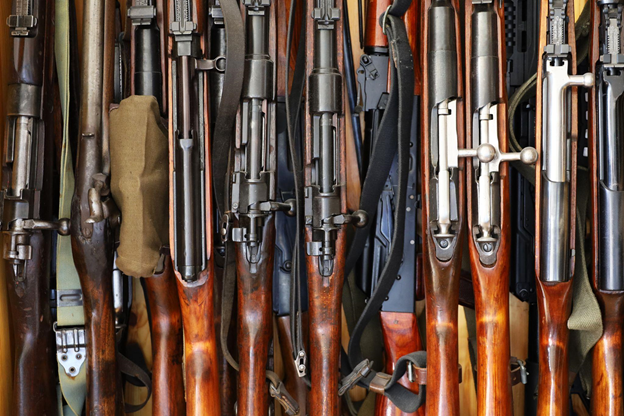How to Care for an Old Military Surplus Gun
Mar 25th 2025
Military surplus guns can represent incredible value, and sometimes you can come across a real, one-of-a-kind treasure in surplus collections.
With that said, many military surplus guns have been through it, and hard. Surplus guns that have seen service or prolonged storage under adverse conditions will show it.
Now, if you’re going to put good money into the purchase of an antique firearm, even if you don’t intend to use it or restore it to a functional state, it’s worth your while to read up on how to properly maintain and store it.
That way, when you open up the safe in a year or two to investigate, hopefully you’ll be greeted by a gun that’s in the same condition as when you bought it, and not just a rust stain on the side and floor of the safe.
That being the case, here are some high level notes for how to store your military surplus guns properly, so that they hold their value and do not deteriorate.
Temperature and Humidity
Regardless of the model of military surplus gun you are trying to preserve, the best thing you can do is keep the environment stable.
Most military surplus guns will be assembled of steel, aluminum, and wood, perhaps with some other materials mixed in. Fluctuations in temperature and humidity will damage these materials.
Also, across large swaths of North America, the average relative humidity is often higher than 50%. This is not good for gun storage, to say the least.
What you want to do is store your guns in a very dry environment, preferably below 30% humidity, although, per official materials disseminated by the NRA, between 30% and 50% (though no higher) is acceptable.
If the humidity is higher, the wood may rot and the metal may corrode. Too much lower and the wood may warp or crack. Whatever the percentage is, keep it there.
This also raises a note that you should store your guns in a room in the house that is not too humid and which experiences minimal fluctuations. Avoid the cellar, basement, attic, crawl space, garage, or shed, unless these are climate controlled.
You can also invest in a dehumidifier for your safe to keep the humidity constant. It’s probably worth it if you’re going to make an investment in an old firearm.
Temperature is another concern, as temperature swings can also accelerate warping, cracking, corrosion and other issues. Keeping the temperature at a consistent 70℉ is a good place to start.

Protecting with Microcrystalline Wax: Notes
While oil will protect your gun, all oils will eventually evaporate, leaving the metal bare and exposing it to corrosive influences. Waxes and greases are more chemically stable and will last longer, affording long-term protection to a gun’s metal components. That’s why cosmoline, which is a very thick grease, has been so widely used to preserve guns in storage.
The NRA suggests microcrystalline wax, which is harder and longer-lasting than many alternatives. Microcrystalline wax is hard and stable, and applying a very thin layer will last a long time, even under adverse conditions.
Buy a small can of microcrystalline wax and apply it to the gun, as per the manufacturer recommendations. Only a thin layer is necessary and you will spread the layer around by handling the gun with gloves (see below). For a shinier surface you can buff the wax after application.
One last note: if the gun is dirty or has signs of corrosion, remove the surface corrosion and give the gun a light cleaning before applying the wax to prevent corrosive agents from being trapped underneath the wax layer.
Preserving Wood Gun Furniture
Just like the gun’s steel and aluminum hardware, a gun’s wooden furniture, such as the stock and forend, also need to be carefully protected and preserved.
There are many types of conditioners that can be applied to wood to help prevent it from absorbing moisture or rotting. Some of these include danish oil, tung oil, and boiled linseed oil. There are also special gunstock conditioners you can buy and apply after lightly cleaning the wood.
Treating the surface of a wooden gunstock with a special oil formulated for wood will help prevent it from rotting and it will also fill and seal the wood pores so that it does not absorb any moisture.
After cleaning the wood, before you store your military surplus gun, do not store it in a sock, sleeve or case. These will trap moisture and can accelerate rot and corrosion.
One more note about storing an old gun. From time to time, even if you don’t take your gun out to inspect or handle it, you should dust it lightly. While the dust itself likely won’t damage the gun, dust can attract and trap moisture and other substances that can hasten the deterioration of the firearm.
Look More, Handle Less
Our final note is that the more you handle your military surplus guns, the faster they will deteriorate. It’s not enjoyable not to be able to survey your wares, though, so here’s another note from the NRA: get some white cotton gloves.
You can handle your military surplus and antique guns with white cotton gloves because the gloves will prevent corrosive salts and oils from your skin from contacting the wood and metal of the gun. As an added bonus, the rust particles will stain white gloves easily, so you will know if you need to apply more wax or grease to the gun after handling.

Explore a Wide Collection of MIlitary Surplus Guns
Whatever you’re here for, we have guns and gun parts for a massive inventory of different platforms from across history and around the globe. Take a look through our expansive collection of military surplus guns and get in touch with us if you have any questions.

